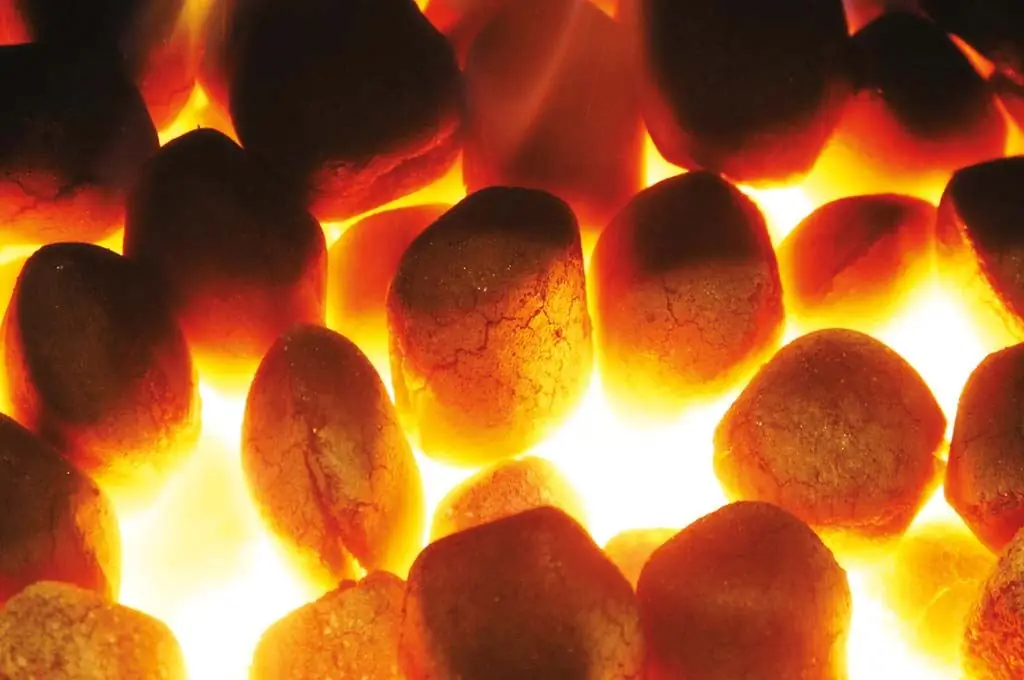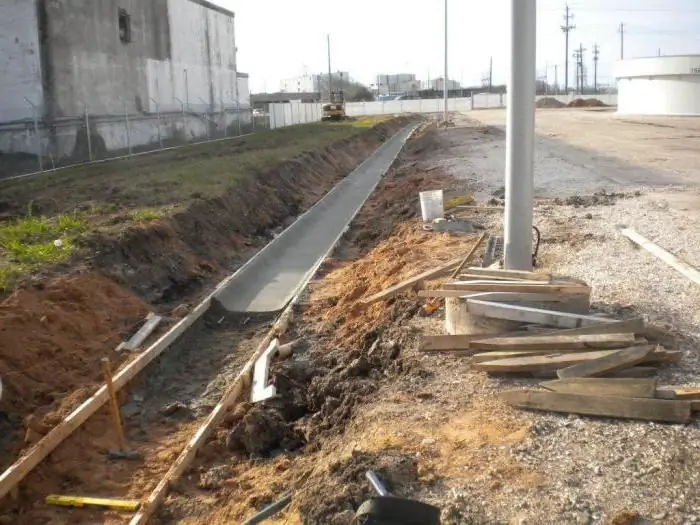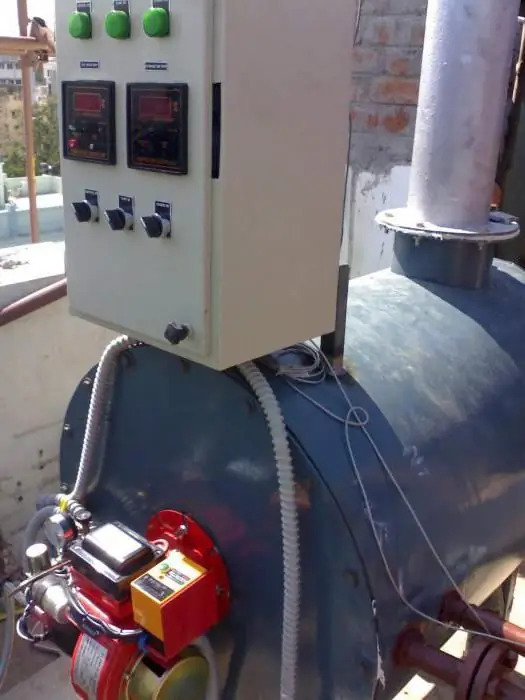2025 Author: Howard Calhoun | [email protected]. Last modified: 2025-01-24 13:10:45
It is customary to call a boiler a furnace designed to operate as the main unit of a water heating system and equipped with a heat exchanger for a liquid heat carrier. Solid fuel heating boilers are an excellent solution for a country house in an area where there is no gasification. Universal, economical and fireproof heating systems built on the basis of a solid fuel boiler will provide heat, hot water and create comfort in the house. And all this at a reasonable price.
Types of heating boilers by energy source
In addition to the obvious advantages of living outside the city, the owner of a country house also bears a considerable responsibility - including for the heat in the house. For heating and hot water systems, the following types of systems are used:
- Electrical.
- Liquid fuel.
- Gas.
- Solid fuel.
Each of the classes has its own advantages and disadvantages. The solution for heating a private house with a solid fuel boiler is differentthe greatest versatility in terms of the fuel used, high autonomy and the lowest cost per kilowatt of heat. In addition, atmospheric systems with natural circulation of the coolant do not depend on interruptions in the power supply network. If there is no centralized gas supply in your area, it makes sense to consider solid fuel heating boilers.
Solid fuels
The most widely used solid fuel for heating boilers is:
- Firewood.
- Coal.
- Peat.
- Briquettes (euro firewood).
- Pellets.
Each type of fuel has its own advantages and disadvantages, and many of them are determined by the geographical and economic characteristics of a particular region. When choosing a device, you must definitely think about what kind of fuel it will be heated and evaluate the cost-effectiveness of a particular choice.
Manufacturers produce solid fuel heating boilers both optimized for a particular type of fuel and universal.
Firewood
This is the oldest type of fuel mastered by mankind. Traces of primitive fires are found at sites dating back several tens of thousands of years ago.

Today, birch and aspen firewood is the most widely used. Less often - alder, oak and firewood of coniferous trees. Birch firewood is the leader in terms of calorific value, but contains a lot of tar. When burned, it turns into soot that clogs the chimney. Aspen gives less heat, but the chimney has toclean much less frequently. Oak firewood gives a lot of heat and burns for a long time, but is too expensive for permanent use. Alder wood gives a pleasant smell, so they are more often burned in open fireplaces. Softwood firewood is not bad in terms of calorific value, but contains a lot of tar, and the resulting soot clogs the chimney even faster than when burning birch firewood.
The advantage of firewood is its availability and a small amount of dust and dirt when used. The disadvantage is that the wood can become damp, which can significantly reduce its fuel efficiency or even make it impossible to fire.
Coal
Coal is widely used for heating. They heat both coal and brown coal.
Coal has a high carbon content, it has a high calorific value and produces little ash and slag. Brown coal is of lower quality, contains many impurities, produces less heat and produces more gases, ash and slag. Its only advantage is its relative cheapness.

Coal does not dampen and has a high calorific value, one and a half to two times higher than that of firewood. The disadvantage of coal is dust and dirt when using it.
Peat
Peat is extracted from swamps, dried and pressed into briquettes.
Has a medium calorific value, burns with a large amount of smoke. It is used in regions where there are few forests, but there are swamps.
Briquettes
This is compressed sawdust the size of a small brick, processed in a kilncameras. They are distinguished by high heat dissipation and the ability to long-term uniform burning.

Pellets
Looks like small compressed sawdust pellets and is sized to be mechanically fed from a hopper.

Solid fuel boilers
Systems for solid fuel water heating have been used by man since ancient times. The boiler itself was copper, the floor heating pipes were ceramic, the combustion chamber was just a space under the boiler. The physical and chemical basis of the operation of the device was a simple process of burning wood or peat. Over the past millennia, the design of the boiler has become noticeably more complicated, new materials and physical and chemical processes have been used, the number of inventions and patents is in the hundreds.
Modern solid fuel home heating boiler is a high-tech unit with an efficiency of up to 80%.
Depending on the type of fuel used, solid fuel systems are divided into:
- Wood and coal. The calorific value of coal is about one and a half times higher than that of mass-produced wood. The combustion temperature of coal is also significantly higher. The design of wood and coal boilers differ insignificantly, mainly they come down to differences in fuel loading systems and ash and slag removal.
- Universal. Most devices belong to this class. Moreover, many models haveoption to install a separately purchased gas or oil burner.
- Peat (briquette).
- Pellet. The pellet boiler is equipped with a bunker for storing fuel and a mechanical system for feeding pellets into the combustion chamber. It is controlled by an automation system that maintains the set parameters for the temperature of the coolant or the temperature in the rooms.

Such a boiler is distinguished by the greatest autonomy among all types of solid fuel devices and can work without the intervention of the owner from a week to a month - everything is determined only by the size of the bunker and heat consumption. The pellet system requires more space for its installation, the mechanical fuel supply system needs periodic maintenance and adjustment.
Traditional oven
A traditional stove (Russian, Dutch, etc.) works as follows: solid fuel placed on a grate is burned in the combustion chamber. At this time, full access of air is open through the blower located below the grate and the exhaust damper (view) is open. More or less opening the blower, you can adjust the draft and the rate of combustion of the fuel. As the fuel burns out, hot combustion products are released from it, including carbon monoxide, which is hazardous to he alth. Passing through a winding chimney left among the brickwork, these gases heat the brick. After the release of gaseous products is completed (the blue flames over the coals have disappeared), the blower and the exhaust damper are closed so that the heat fromcooling coals and brickwork did not escape into the atmosphere. However, most of the heat generated from burning fuel is released into the atmosphere.
Long burning boilers
Sellers often call anyone capable of maintaining a smoldering mode a long-burning boiler. In the strict sense of the definition, a long-burning solid fuel heating boiler must operate on one load of fuel for at least a day.

The long burning mode is implemented due to the slow burning of fuel in conditions of lack of oxygen. At the same time, the chemical process of pyrolysis begins, which consists in the release of combustible gases from solid fuel and their subsequent combustion. The gases released during pyrolysis have a significantly higher calorific value than wood or coal, and are simply released into the atmosphere in a traditional furnace.
Types of long burning boilers
Heating boilers for long-burning solid fuels are manufactured according to several schemes.
- Non-volatile or atmospheric. The movement of air in them is carried out due to natural draft. They have a slightly lower thermal efficiency, but do not depend on the stability of the power supply.
- Supercharged. In this type of boilers, air is supplied by a fan, an automatic system controls the air flow. This design allows maximum heat dissipation, but is dependent on power supply.
In addition, boilers are single-circuit and double-circuit. Single-circuit boilers are designed only forheating, double-circuit, along with heating, also provide hot water.
Choosing a solid fuel boiler
A wide variety of solid fuel boilers for heating a private house are on the market. To choose a boiler, it is necessary to clearly formulate the requirements for the future apparatus.
The key parameters influencing the choice of a boiler are:
- Heat power.
- Autonomy.
- Fuel type.
- Number of contours.
- Type of boost.
- Price.
The main characteristic of the boiler is its heat output, which determines the area of the building that this model can heat.
So, for a house with an area of 60 m22 9 kW of thermal power is enough, and for a two-storey cottage with a total area of 200 m2 it is better to choose 25 or 30 kW, depending on the climatic zone, the average annual and minimum temperature. The quality of thermal insulation also affects the power of the boiler. If, for example, the boiler is bought to heat an old house built without the use of heat-saving technologies, the boiler capacity will have to be increased.
Autonomy means the time from loading to loading fuel at medium power. The maximum autonomy (up to one month) is provided by pellet boilers with automatic feeding, the minimum is provided by atmospheric devices that work on wood (up to 12 hours)
The next parameter is the type of fuel. You should choose a boiler that runs on fuel that is affordable and affordable in the region. If you have not decided on fuel,choose a universal boiler.
Number of heating circuits. A double-circuit boiler is more expensive and more difficult to connect. If the hot water consumption is planned to be small, then it is easier to install an electric water heater. In addition, in summer, when there is no need for heating, you do not have to heat the boiler.
The price of solid fuel boilers for water heating starts from 20 thousand rubles. For this money, you can purchase the simplest single-circuit atmospheric boiler with manual power control. A long-burning boiler with automation will cost about 35-40 thousand rubles. From 120 thousand rubles. there is a solid fuel pellet boiler. The price of a fully automated boiler with a bunker designed for a monthly supply of pellets will approach 300 thousand rubles. For a comparable amount, you can supply an entry-level autonomous gas supply system.
DIY boiler
Do-it-yourself solid fuel heating boilers can be made from a used gas cylinder and scraps of steel pipes and fittings. Of course, if you have welding and metalwork skills at a sufficient level. In terms of energy efficiency, it is unlikely to even come close to industrial designs, but it will cost you the price of electrodes.
Required:
- Gas bottle, 50 liters.
- Steel angle 3030, 1 running meter.
- Reinforcement with a diameter of 8-12 mm, 2 running meters.
- Steel pipe 2 inches, scraps from 40 cm - 6 pcs
- Bulgarian.
- Welding machine.

Balloon disposevertically and weld legs to it from the corner for support. In the lower part, a door is cut out for a blower and an ash tray, immediately above it, several parallel pieces of reinforcement are welded across the cylinder - this will be a grate. In the middle part, a door is cut out for loading fuel. In the upper part of the cylinder, 8 holes with a diameter of 50 mm are cut out so that 4 parallel pipe cuts are inserted into them and the gaps are welded. From the 2 remaining pieces of pipe, 2 collectors are made connecting the protruding ends of the pipes. One end is welded, the other end is threaded for connection to a water heating system. The cut-out doors are hung on the body using purchased or self-made hinges. Sometimes industrial cast iron doors are used to improve the appearance.
Compared to industrial designs, the efficiency will be low, and the appearance will be more than modest. However, such solid fuel heating boilers will operate properly and are quite suitable for heating a gatehouse or greenhouse.
Recommended:
Solid fuel is Types, characteristics and production of solid fuel

Non-fossil solid fuel based on wood and industrial waste - affordable and efficient fuel. The modern market offers a wide range of solid fuels, differing in efficiency and characteristics
Tray for heating mains: dimensions, GOST. Reinforced concrete trays for heating mains

Reinforced Concrete Heating Tray is rectangular in shape and has a gutter configuration. The parameters for the type of width, length and height of different models differ from each other. The structures are made of heavy concrete, which, after hardening, are extremely resistant to various types of loads. In addition, these trays are frost-resistant
Greenhouse heating: heating methods

In spring and summer, thanks to the natural conditions in the greenhouse, you can grow different crops without additional heat. And in autumn, winter and early spring, when both the soil and the air are cold, it is very difficult to grow something in a greenhouse. This is why greenhouse heating is necessary
Heating oil as an alternative to traditional heating

Heating oil has become the most demanded resource for heat production. It is not advisable to use gas and electricity as space heating and water. Moreover, when burned, heating oil releases much more energy than diesel fuel, making it the most suitable energy source for home heating
Industrial boilers: description, types, functions. Industrial expertise of boilers

The article is devoted to industrial boilers. The varieties of such units, functions and nuances of the examination for the safety of equipment are considered

